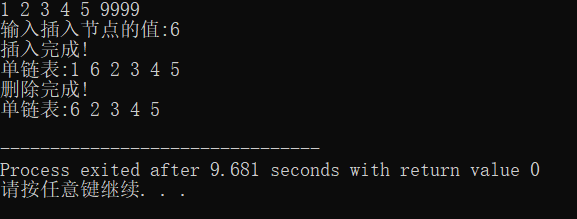一.线性表的顺序存储
typedef int ElemType;
typedef struct List
{
ElemType *data;//动态分配 ,需要申请空间
int length;
}List;
0.完整代码


#include <stdio.h>
#include <stdlib.h>
#define MaxSize 50
#define TRUE 1
#define FALSE 0
typedef int ElemType ;
struct List
{
ElemType *data;//动态分配 ,需要申请空间
int length;
};
void InitList(List *p);//初始化表
int ListInsert(List *p,int i,ElemType e);//插入操作 (前插),在第i个位置插入数据e
int ListDelete(List *p,int i);//删除操作,删除第i个位置数据
int ListFindValue(List L,ElemType e);//按值查找元素e ,返回e在顺序表表的位置
int ListFindLocate(List L,int i);//按位查找第i位的值
int Empty(List L); //判空,如果表为空返回TRUE
void PrintList(List L);//输出操作
int main()
{
List L;
InitList(&L);
ListInsert(&L,1,1);
ListInsert(&L,2,3);
ListInsert(&L,3,5);
ListInsert(&L,4,7);
ListInsert(&L,5,9);
PrintList(L);
return 0;
}
void InitList(List *p)
{
p->data=(ElemType*)malloc(sizeof(ElemType)*MaxSize);
p->length=0;
}
int ListInsert(List *p,int i,ElemType e)
{
if(i<1 || i>p->length+1)
{
return FALSE;//插入位置不合法
}
if(p->length>=MaxSize)
{
return FALSE;//顺序表已满
}
for(int j=p->length;j>=i;j--)
{
p->data[j]=p->data[j-1];
}
p->data[i-1]=e;
p->length++;
return TRUE;
}
int ListDelete(List *p,int i)
{
if(i<1 || i>p->length)
{
return FALSE;
}
for(int j=i;j<p->length;j++)
{
p->data[j-1]=p->data[j];
}
p->length--;
return TRUE;
}
int ListFindValue(List L,ElemType e)
{
for(int i=0;i<L.length;i++)
{
if(L.data[i]==e)
{
return i+1;
}
}
return FALSE;
}
int ListFindLocate(List L,int i)
{
return L.data[i-1];
}
void PrintList(List L)
{
for(int i=0;i<L.length;i++)
{
printf("%d ",L.data[i]);
}
printf("\n");
}
int Empty(List L)
{
if(L.length==0)
{
return TRUE;
}
else
{
return FALSE;
}
}1.初始化顺序表


void InitList(List *p)
{
p->data=(ElemType*)malloc(sizeof(ElemType)*MaxSize);
p->length=0;
}2.插入操作 ,在第i个位置插入数据e


int ListInsert(List *p,int i,ElemType e)
{
if(i<1 || i>p->length+1)
{
return FALSE;//插入位置不合法
}
if(p->length>=MaxSize)
{
return FALSE;//顺序表已满
}
for(int j=p->length;j>=i;j--)
{
p->data[j]=p->data[j-1];
}
p->data[i-1]=e;
p->length++;
return TRUE;
}3.删除操作,删除第i个位置数据


int ListDelete(List *p,int i)
{
if(i<1 || i>p->length)
{
return FALSE;
}
for(int j=i;j<p->length;j++)
{
p->data[j-1]=p->data[j];
}
p->length--;
return TRUE;
} 4.按值查找元素 ,返回元素在顺序表的位置


int ListFindValue(List L,ElemType e)
{
for(int i=0;i<L.length;i++)
{
if(L.data[i]==e)
{
return i+1;
}
}
return FALSE;
}5.按位置查找元素


int ListFindLocate(List L,int i)
{
return L.data[i-1];
}6.判断顺序表是否为空,为空返回TRUE


int Empty(List L)
{
if(L.length==0)
{
return TRUE;
}
else
{
return FALSE;
}
}7.显示顺序表


void PrintList(List L)
{
for(int i=0;i<L.length;i++)
{
printf("%d ",L.data[i]);
}
printf("\n");
}二.线性表的链式存储

typedef int ElemType;
typedef struct Node{
ElemType data;
struct Node *next;
}Node;0.完整代码


1 #include <stdio.h>
2 #include <stdlib.h>
3 #define TRUE 1
4 #define FALSE 0
5 typedef int ElemType;
6 typedef struct Node{
7 ElemType data;
8 struct Node *next;
9 }Node;
10
11 Node* InitNode();//初始化创建头结点
12 Node* Node_HeadInsert(Node *L);//头插法建立链表
13 Node* Node_TailInsert(Node *L);//尾插法建立链表
14 Node* NodeInsert(Node *L,int i);//在第i个位置插入结点
15 Node* NodeDelete(Node *L,int i);//删除第i个结点
16 Node* NodeSearchNum(Node *L,int i);//按序号查找
17 Node* NodeSearchValue(Node *L,ElemType x);//按值查找
18 void PrintNode(Node *L);//显示单链表
19 Node* NodeMerge(Node *p,Node *q);//合并两个递增链表
20
21
22 int main()
23 {
24 Node *L;
25 L=InitNode();
26 L=Node_TailInsert(L);
27 L=NodeInsert(L,2);
28 PrintNode(L);
29 L=NodeDelete(L,1);
30 PrintNode(L);
31 return 0;
32 }
33 Node* InitNode()
34 {
35 Node *L;
36 L=(Node*)malloc(sizeof(Node));
37 L->next=NULL;
38 return L;
39 }
40 Node* Node_HeadInsert(Node *L)
41 {
42 Node *s;
43 ElemType x;
44 scanf("%d",&x);//插入结点的值
45 while(x!=9999)
46 {
47 s=(Node*)malloc(sizeof(Node));
48 s->data=x;
49 s->next=L->next;
50 L->next=s;
51 scanf("%d",&x);
52 }
53 return L;
54 }
55
56 Node* Node_TailInsert(Node *L)
57 {
58 ElemType x;
59 Node *s,*r=L;
60 scanf("%d",&x);
61 while(x!=9999)
62 {
63 s=(Node*)malloc(sizeof(Node));
64 s->data=x;
65 r->next=s;
66 r=s;
67 scanf("%d",&x);
68 }
69 r->next=NULL;
70 return L;
71 }
72
73 Node* NodeInsert(Node *L,int i)
74 {
75 ElemType x;
76 Node *s,*p=NodeSearchNum(L,i-1);
77 printf("输入插入节点的值:") ;
78 scanf("%d",&x);
79 s=(Node*)malloc(sizeof(Node));
80 s->data=x;
81 s->next=p->next;
82 p->next=s;
83 printf("插入完成!\n");
84 return L;
85 }
86
87 Node* NodeDelete(Node *L,int i)
88 {
89 Node *p,*q;
90 p=NodeSearchNum(L,i-1);
91 q=p->next;
92 p->next=q->next;
93 free(q);
94 printf("删除完成!\n");
95 return L;
96 }
97
98 Node *NodeSearchNum(Node *L,int i)
99 {
100 int count=1;//计数
101 Node *p=L->next;
102 if(i==0)
103 return L;
104 if(i<1)
105 return NULL;
106 while(p&&count<i)
107 {
108 p=p->next;
109 count++;
110 }
111 return p;
112 }
113
114 Node *NodeSearchValue(Node *L,ElemType x)
115 {
116 Node *p=L->next;
117 while(p&&p->data!=x)
118 {
119 p=p->next;
120 }
121 return p;
122 }
123 void PrintNode(Node *L)
124 {
125 Node *p=L->next;
126 printf("单链表:");
127 while(p)
128 {
129 printf("%d ",p->data);
130 p=p->next;
131 }
132 printf("\n");
133
134 }
135
136 Node* NodeMerge(Node *p,Node *q)
137 {
138 Node *r,*t;
139 r=InitNode();
140 t=r;
141 while(p->next&&q->next)
142 {
143 if(p->next->data<q->next->data)
144 {
145 t->next=p->next;
146 p->next=p->next->next;
147 t=t->next;
148 }
149 else
150 {
151 t->next=q->next;
152 q->next=q->next->next;
153 t=t->next;
154 }
155 }
156
157 while(p->next)
158 {
159 t->next=p->next;
160 p->next=p->next->next;
161 t=t->next;
162 }
163
164 while(q->next)
165 {
166 t->next=q->next;
167 q->next=q->next->next;
168 t=t->next;
169 }
170
171 free(p);
172 free(q);
173
174 return r;
175 }1.初始化创建头结点


Node* InitNode()
{
Node *L;
L=(Node*)malloc(sizeof(Node));
L->next=NULL;
return L;
}2.头插法建立链表


Node* Node_HeadInsert(Node *L)
{
Node *s;
ElemType x;
scanf("%d",&x);//插入结点的值
while(x!=9999)
{
s=(Node*)malloc(sizeof(Node));
s->data=x;
s->next=L->next;
L->next=s;
scanf("%d",&x);
}
return L;
}3.尾插法建立链表


Node* Node_TailInsert(Node *L)
{
ElemType x;
Node *s,*r=L;
scanf("%d",&x);
while(x!=9999)
{
s=(Node*)malloc(sizeof(Node));
s->data=x;
r->next=s;
r=s;
scanf("%d",&x);
}
r->next=NULL;
return L;
}4.在第i个位置插入结点


Node* NodeInsert(Node *L,int i)
{
ElemType x;
Node *s,*p=NodeSearchNum(L,i-1);
printf("输入插入节点的值:") ;
scanf("%d",&x);
s=(Node*)malloc(sizeof(Node));
s->data=x;
s->next=p->next;
p->next=s;
printf("插入完成!\n");
return L;
}5.删除第i个结点


Node* NodeDelete(Node *L,int i)
{
Node *p,*q;
p=NodeSearchNum(L,i-1);
q=p->next;
p->next=q->next;
free(q);
printf("删除完成!\n");
return L;
}6.按序号查找


Node *NodeSearchNum(Node *L,int i)
{
int count=1;//计数
Node *p=L->next;
if(i==0)
return L;
if(i<1)
return NULL;
while(p&&count<i)
{
p=p->next;
count++;
}
return p;
}7.按值查找


Node *NodeSearchValue(Node *L,ElemType x)
{
Node *p=L->next;
while(p&&p->data!=x)
{
p=p->next;
}
return p;
}8.显示单链表


void PrintNode(Node *L)
{
Node *p=L->next;
printf("单链表:");
while(p)
{
printf("%d ",p->data);
p=p->next;
}
printf("\n");
}9.合并两个递增链表


Node* NodeMerge(Node *p,Node *q)
{
Node *r,*t;
r=InitNode();
t=r;
while(p->next&&q->next)
{
if(p->next->data<q->next->data)
{
t->next=p->next;
p->next=p->next->next;
t=t->next;
}
else
{
t->next=q->next;
q->next=q->next->next;
t=t->next;
}
}
while(p->next)
{
t->next=p->next;
p->next=p->next->next;
t=t->next;
}
while(q->next)
{
t->next=q->next;
q->next=q->next->next;
t=t->next;
}
free(p);
free(q);
return r;
}输出示例:

2020-06-27
来源:oschina
链接:https://my.oschina.net/u/4386188/blog/4327064